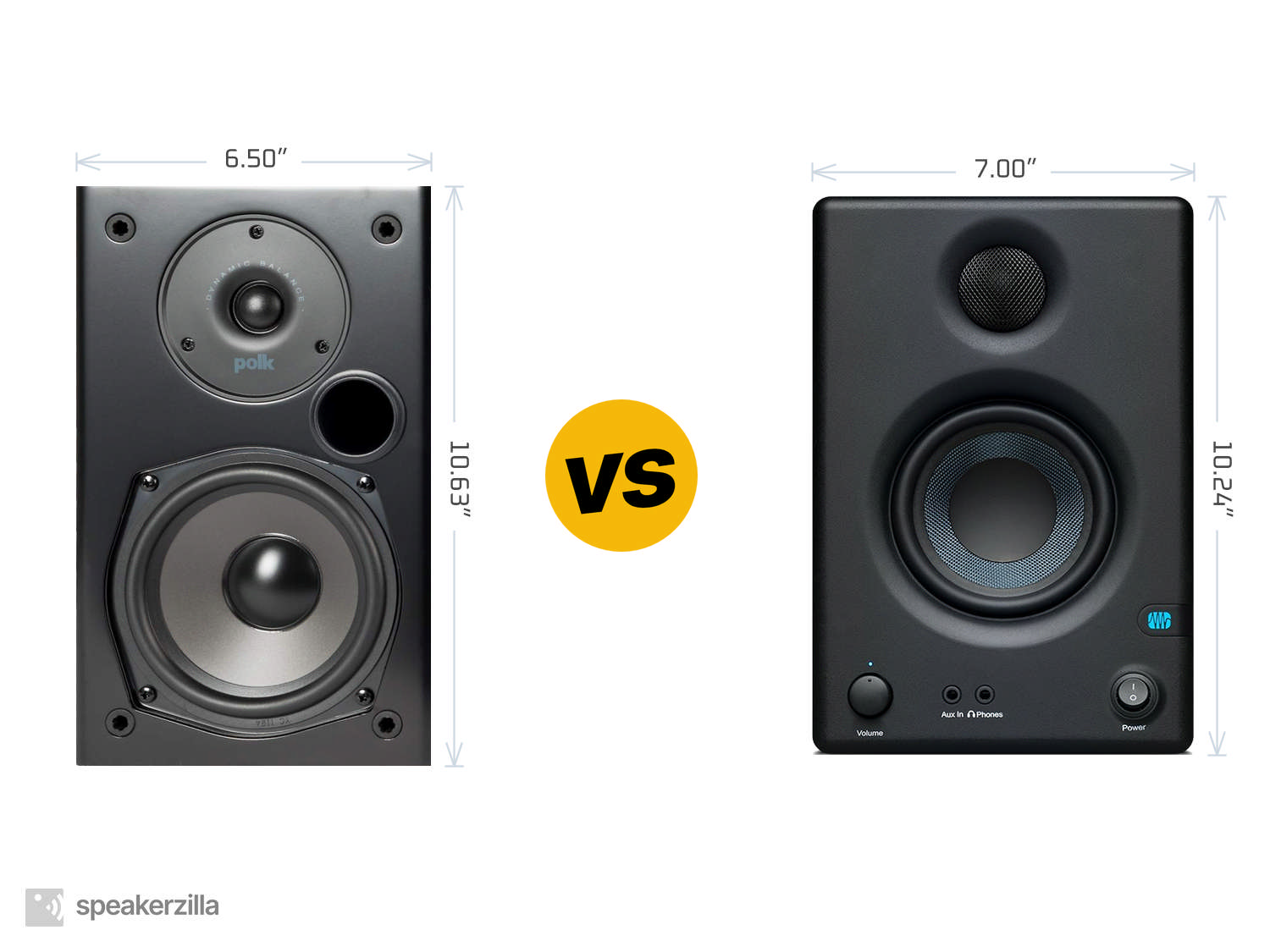Polk Audio T15 vs. Presonus Eris E3.5

| Polk Audio T15 Bookshelf Speakers | Presonus Eris E3.5 3.5” Near Field Studio Monitor |
| MSRP | |
| $150 | $100 |
| Dimensions (H × W × D) | |
|
10.63” × 6.50” × 7.25” 270mm × 165mm × 184mm |
10.24” × 7.00” × 7.68” 260mm × 178mm × 195mm |
| Power Type | |
| Passive | Powered |
| Frequency Response | |
| 65-20,000 Hz | 80-20,000 Hz |
| ASR Score | |
| 0.3 | 1.5 |
| ASR Score w/Subwoofer | |
| 3.3 | 4.3 |
|
Amazon.com
|
Amazon.com
|
Key Takeaways
TLDR Summary: In the realm of affordable, compact speakers, the Polk Audio T15 bookshelf speakers boast a warm sound profile and wide soundstage, suitable for casual listening and home theater systems. They're known for their robust construction and versatility. On the flipside, the PreSonus Eris E3.5 studio monitors deliver accurate, flat response, catering to budding audio producers seeking clarity and detail for mixing tasks. Their compact form factor is perfect for small studios. Each set serves a different audience—Polk appeals to general consumers while PreSonus targets the entry-level production market, each excelling within their intended applications.
Speaker Comparison
When it comes to outfitting a listening space, the choice of speakers can make or break the auditory experience. In the realm of modestly sized, wallet-friendly audio solutions, the Polk Audio T15 Bookshelf Speakers and the PreSonus Eris E3.5 Near Field Studio Monitors both offer tantalizing propositions for different reasons. While the T15s are often touted for casual listening in a home setting, the Eris E3.5 monitors are engineered with the precision required for audio production. But how do these two contenders fare when pitted against each other in the arena of sound quality, design, and value? Let's dive into the details.
Tonal Balance and Sound Signature
The Polk Audio T15s deliver a warm and inviting sound that is quite forgiving on less-than-perfect recordings, making them a great match for a broad variety of genres. The bass response, while not overwhelming, is adequate for their size. In contrast, the PreSonus Eris E3.5 monitors boast a flat frequency response that brings out the nuances in the mix, making them ideal for scrutinizing the fine details in music production or enjoying high-quality recordings. The E3.5s provide a clear and uncolored sound that highlights the accuracy over embellishment.

 (at Amazon.com)
(at Amazon.com)Design and Build Quality
The Polk T15s sport a no-frills, traditional aesthetic that should blend well with most decors. The build is solid and the textured finish adds a touch of class. On the flip side, the PreSonus Eris E3.5 monitors have a more professional studio look with a sleek and compact design that exudes functionality. The woven composite drivers not only contribute to the monitors' sound accuracy but also give them a distinctive appearance. Both sets of speakers are well-constructed, but the E3.5s edge ahead with a design that's as functional as it is attractive.
Connectivity and Versatility
Connectivity is an area where the two speakers diverge significantly. The Polk T15 is a passive speaker, requiring an external amplifier or receiver to bring its drivers to life. This means that they can fit into a larger home audio system with relative ease. The PreSonus Eris E3.5, on the other hand, is an active studio monitor, featuring built-in amplification and a variety of inputs, including TRS, RCA, and even a convenient front-panel aux input for mobile devices. This self-sufficiency makes the E3.5s a versatile choice for those with limited space or who prefer a more streamlined setup.

 (at Amazon.com)
(at Amazon.com)Both the Polk T15 and the PreSonus Eris E3.5 punch above their weight when it comes to performance per dollar. The T15s are often praised for their value, providing a sound that defies their affordable price point. They're an excellent entry-level choice for the burgeoning audiophile or casual listener. Meanwhile, the Eris E3.5 monitors also represent significant value, with their studio-grade sound and versatility justifying the slightly higher cost. For those in need of accurate sound reproduction for multimedia creation or consumption, the E3.5s are worth every penny.
Compare to similar speakers
When considering the usability in different environments, the Polk Audio T15 speakers are more suited for traditional home audio setups. They work well as part of a stereo pair or as satellite speakers in a surround sound system. Conversely, the PreSonus Eris E3.5 monitors are designed primarily for near field listening - perfect for desktop settings where space is at a premium and the listener is seated relatively close to the speakers.
In summary, choosing between the Polk Audio T15 Bookshelf Speakers and the PreSonus Eris E3.5 3.5” Near Field Studio Monitor comes down to the intended use and personal preferences in sound reproduction. The T15s offer a pleasant, room-filling sound ideal for casual listening in a home environment, while the Eris E3.5s cater to those seeking precision and clarity for professional or hobbyist audio work. Both models offer impressive performance for their price brackets, but understanding their strengths will guide you to the perfect sound companion for your room and ears.
- Polk Audio T15 reviews and FAQs
- Presonus Eris E3.5 reviews and FAQs
Check Current Prices: |
|
|
Amazon.com
|
Amazon.com
|
Affiliate Disclosure: As an Amazon Associate, we earn from qualifying purchases.

